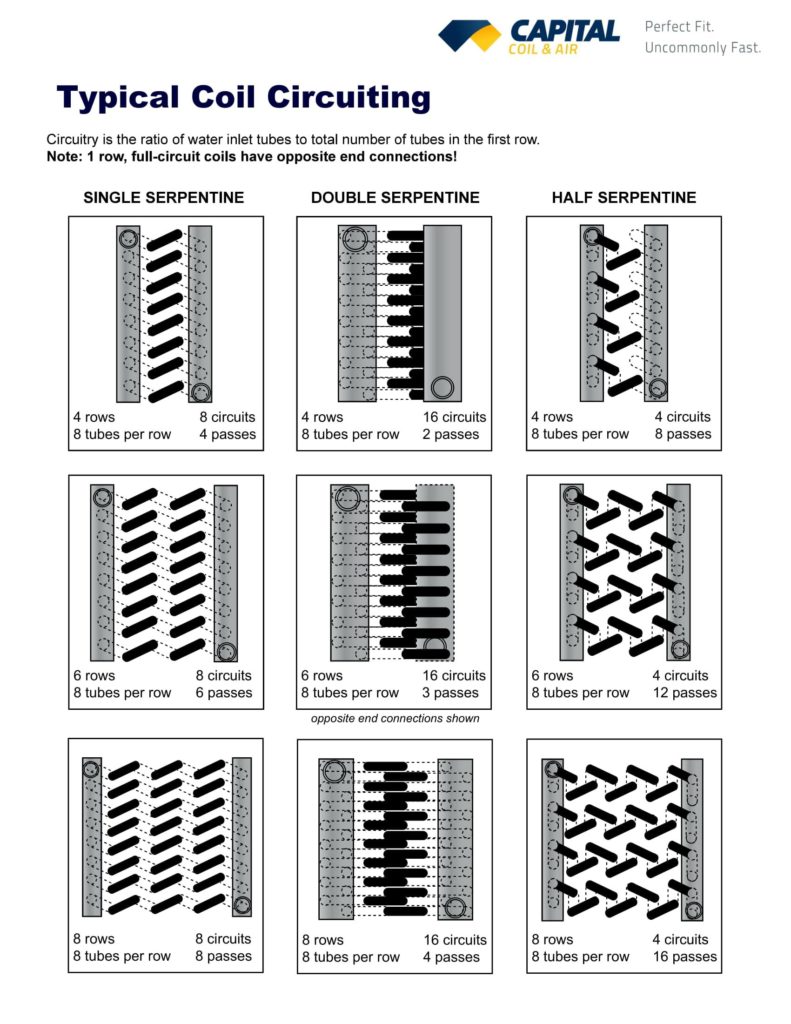Chilled Water Coils – Circuiting Made Easy
by Dan Jacobs, December 17, 2024

Circuiting chilled water coils is one of life’s great challenges in the coil business. You’re bound to run across folks with years of experience in the industry that can not effectively explain this concept. While not the most exciting of subjects, the necessity of circuiting chilled water coils can not be overstated. Capital Coil & Air has attempted to simplify the idea of circuiting as much as possible.
For starters, circuiting chilled water coils is ultimately up to the performance of those coils. Circuiting is really a balancing act of tube velocity and pressure drop. In other words, think of a coil as a matrix. Each coil has a specific number of rows, and a specific number of tubes within each row. For example, a chilled water coil might be 36 inch fin height and 8 rows deep. The coil has 24 tubes in each row, and multiplied by 8 rows, there is a total of 192 tubes within the coil. While you can try to feed any number of tubes, there are only a few combinations that will work.
-
- Feeding 1 tube – you will be making 192 passes through the coil, which will essentially require a pump the size of your car to make that process work.
-
- Feeding 2 tubes – equates to 96 passes, and your pressure drop will still be enormous.
-
- Feeding 3 tubes – 64 passes, which is still too many.
-
- Feeding 4 tubes – See above.
-
- Feeding 5 tubes – Impossible as 5 does not divide evenly into 192 (passes).
-
- Feeding 6 tubes – Still constitutes far too many passes, which again leads to additional pressure drop.
-
- Feeding 7 tubes – Same rule for feeding 5 tubes.
-
- Feeding 8 tubes – Same rule for feeding 6 tubes.
-
- Feeding 24 tubes – This feed consists of 8 passes, which is in the ballpark, and with a pressure drop you can live with.
-
- Feeding 32 tubes – 32 tubes will see 6 passes. You might see a slight decrease in performance, but it’s off-set by a continuously better pressure drop.
- Feeding 48 tubes – The magic combination, as 4 passes typically elicits the best performance and pressure drop simultaneously.
Rule #1: The number of tubes that you feed must divide evenly into the number of tubes in the chilled water coil.
Rule #2: The chilled water coil must give you an even number of passes so that the connections end up on the same end.
Rule #3: Based on the number of passes, you must be able to live with the resulting pressure drop. Acceptable tube velocity with water is between 2 and 6 ft. per second.
You’re bound to run into different terminologies depending on the manufacturer. More times than not, the different verbiage confuses more than it clarifies. However, understanding the basic tenets of chilled water coil circuiting will remove much of the perceived difficulty.
Related Posts
Coils and Counter-flow: 5 Common Questions
Chilled Water Coils & Moisture Carryover
Top 10 Things You Need to Know About Chilled Water Coils
Tags: Capital Coil & Air, Chilled Water Coils, Circuiting, Commercial Coils, cooling coils, Direct Expansion Coils, DX Coils, HVAC Coils, HVAC Manufacturers, HVAC Techs, OEM Replacement Coils, replacement coils, water coils
